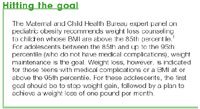Managing overweight adolescents
Insight into which interventions are the most effective in helping adolescent patients fight overweight.

Key Points


A note on the evidence
In July 2005, the United States Preventive Services Task Force (USPSTF) published its recommendation statement: Screening and Interventions for Overweight in Children and Adolescents.4 In this publication, the USPSTF found insufficient evidence for the effectiveness of office interventions in the obese adolescent, due mainly to the lack of studies in office-based settings for this age group. Nevertheless, the USPSTF stressed that "clinicians must work with individual patients and their families" on the issue of overweight. To that end, clinicians must be aware of what interventions have the most potential for being effective, as is showcased in the following pages.
SEDENTARY BEHAVIOR

The medical literature also offers a number of clinical studies aimed at reducing sedentary behavior in children, including smaller randomized controlled trials. However, these studies have not been office-based. Nonetheless, the data shows that reducing time spent in sedentary behaviors will lead to an increase in physical activity, and therefore a reduction of BMI. The most effective interventions to reduce sedentary behavior include: group and individual counseling sessions,6-9 contingent television (making television watching contingent on exercise),10,11 and school-based curricula.12,13